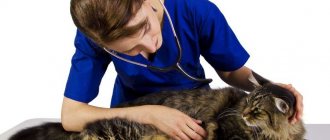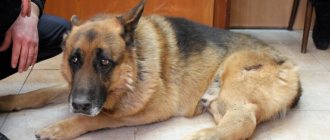Description of the pathology
Cryptorchidism is a common hereditary condition in which one or two testicles do not descend into the scrotum. The testes may be located in the inguinal canal, perineum, or abdominal cavity. Sometimes they cannot be detected even with ultrasound diagnostics. With cryptorchidism, the puppy does not have any complaints, the pet feels great and nothing bothers him.
Typically, the descent of the testes into the scrotum occurs on days 5-10 of the puppy’s life. Depending on the breed, this phenomenon can last up to 2-5 months.
If the testicles are not fixed in the scrotum by six months of age, doctors make a preliminary diagnosis - cryptorchidism. However, veterinarians often advise waiting up to 10 months and re-examining.
Small breeds are more susceptible to the anomaly than large ones. For example, cryptorchidism is often found in Spitz, Yorkshire terrier, pug, Chihuahua, toy terrier, Maltese, poodle, and Pekingese. The probability of pathology is 7-13% of all diseases in male dogs. With this phenomenon, the dog retains its sexual desire and hormone production.
Why does the disease affect animals?
Currently, there are many different reasons for the development of this disease in puppies. This may include:
- the size of the testis (it can be greatly enlarged and not pass into the seed ring);
- narrowing of the inguinal canal, which also results in the inability of the testicle to descend;
- Some male dogs have an underdeveloped scrotum, and this sometimes causes cryptorchidism.
To understand the essence of the disease, you need to know how the testicle develops and how it descends in accordance with the norms.
As a rule, in newly born puppies, the testes are located in the abdominal cavity. But in the future, the action of hormones leads to a natural descent of the testicles into the scrotum. Therefore, if there are not enough hormones, it can slow down or stop the movement of the testis. The disease can also develop due to any inflammatory process with normal hormonal levels.
We recommend reading: If a Cat Eats and Then Vomits It
Basically, the disease develops due to a failure of embryonic development. How the dog’s pregnancy progresses plays a big role here. For example, a pregnant dog should be provided with additional vitamins and minerals.
Reasons for appearance
Despite the fact that the pathology is purely “male”, from which only males suffer, it is genetically transmitted from the female. This is an autosomal recessive inherited abnormality. But this is not always the reason. Among the factors that influence cryptorchidism are:
- Anatomical reasons: narrow inguinal canal, large testes, underdeveloped scrotum, short spermatic cord, formation of connecting folds at the base of the scrotum.
- Mechanical - injuries or bruises of the scrotum and groin area, which slow down the process of descent of the testis.
- Hormonal factors. Insufficient production of testosterone and gonadotropin, which affects the connection of the fundus of the scrotum and testicle.
- Inflammatory processes that lead to reduction or complete obstruction of the inguinal canal and acquired cryptorchidism in dogs.
Most pathologies occur at the intrauterine stage of fetal development, which is associated with improper care of the pregnant bitch by the breeder. Viral diseases or malnutrition can have a bad effect on her offspring.
Prevention
In most cases, cryptorchidism in dogs is a hereditary pathology, the occurrence of which is almost impossible to influence. The only means of prevention is a balanced and nutritious diet for the pregnant bitch, especially at the end of the period of gestation. In addition, the animal should only be paired with healthy males whose ancestors did not suffer from a similar problem.
As for acquired cryptorchidism, associated with injuries and infections, measures to prevent it include keeping the puppy in a warm and dry room, mandatory walks, a well-chosen diet, and timely vaccinations.
Kinds
The following types of anomaly are distinguished:
- bilateral or monolateral cryptorchidism;
- abdominal or inguinal;
- false or true.
Monolateral or unilateral cryptorchidism is a pathology in which one testicle does not descend. This is a common phenomenon in which a male dog retains reproductive function.
Bilateral - when both testicles are fixed outside the scrotum. This form of anomaly is less common. Males with bilateral cryptorchidism are sterile. This is explained by the fact that high temperature in the abdominal cavity disrupts normal spermatogenesis.
The abdominal form is also called the abdominal form. With this phenomenon, the testes can become fixed under the skin of the peritoneum. Often they are detected only during laparoscopy, since ultrasound does not give an accurate result. Inguinal cryptorchidism - when the testicles are located in the groin area. They are easy to detect visually or by palpation.
The true form of the anomaly is when the reduction of the testicle into the scrotum is only permissible through surgery. The testis may be located in the inguinal canal, in the abdominal cavity, in the upper part of the scrotum, or at the inguinal ring.
False cryptorchidism or wandering testicle syndrome. With this phenomenon, the testicles can periodically be retracted into the abdominal cavity and back. This usually happens when there is stress or a sudden change in weather. This anomaly is not considered serious, but male dogs with “wandering” testes are not allowed for breeding.
Cryptorchidism in dogs
In male dogs of any breed, both testicles descend into the scrotum by six months. Before this, they were located in the abdomen, and with age they descend down the seminiferous tubule. From this moment the puppy becomes sexually mature, i.e. can mate individuals of the opposite sex and have offspring. At the age of six months, puppies must be checked by a veterinarian to ensure the correct location of the testicles.
Unfortunately, not all male dogs have the correct development of their genital organs. It also happens that one or two testicles “get stuck” under the pelvic bone and do not descend completely. This disease is called cryptorchidism. Cryptorchidism in dogs is considered a hereditary disease and is transmitted from generation to generation not only through a male, but also through a female. There are two types of cryptorchidism: unilateral and bilateral.
With bilateral cryptorchidism, both testicles do not descend, the male becomes, as it were, sterilized and cannot have offspring. For the dog itself, such a disease may end in an unfavorable outcome in the form of degeneration of the testicles remaining in the abdomen into a malignant formation.
We recommend reading: The Cat Catches Mice
With unilateral cryptorchidism, only one testicle does not descend, so the pet can mate and have offspring. The offspring will also be cryptorchids, not all of them, of course, but they will be. According to the rules of the RKF, such males are not allowed for mating.
Unscrupulous breeders often hide the fact that the puppy’s parents had or have cryptorchid. Moreover, in order for a male with cryptorchidism to be allowed to breed, such breeders go to all sorts of tricks, such as plastic surgery to sew in an artificial testicle. In this case, when assessing a male dog, the commission probes both testicles and gives the go-ahead for mating. In fact, the dog is defective.
Officially, such operations are prohibited both abroad and in Russia, and the veterinarian who performed it will suffer serious punishment, including deprivation of practice. In fact, such operations are performed, but illegally. Just like operations to set the ears (not correction, but plastic surgery, which is also illegal). When buying a puppy for the purpose of further breeding, you should pay the most serious attention to its pedigree. There should not be a single animal suffering from cryptorchidism. It is necessary to look through as many generations of relatives of this puppy as possible, because such operations have not been done before. Those breeders who have nothing to hide will show you all the documents that you want to see.
Males with cryptorchidism must be castrated and every veterinarian will definitely offer this to you. For bilateral cryptorchids this will be a strip operation, and for unilateral cryptorchids it will be surgery plus castration. This must be done, as I already wrote, because of the possibility of the appearance of malignant tumors.
If you did not intend to breed dogs and breed your own, then the diagnosis of cryptorchidism should not sound like a death sentence. Surgery, castration and your dog will delight you for many years to come. If your goal is further breeding, then you have two options: look at pedigrees of several generations or buy a dog over six months of age (some boys have testicles that descend earlier) and only after it has been examined by a veterinarian.
And I would also like to add that massage, medications and other methods of mechanical descent of the testicle rarely lead to success. It is even possible that the testicle will descend, but after an illness and even a change of teeth it will go up again. Everything should happen naturally, not artificially.
My King had one testicle that did not descend and at one time he had strip surgery and castration. The other day my child turned 11 years old. This is absolutely not an aggressive dog and never has been. He is cheerful, lively, playful, spoiled and in character is very far from being a “rug”, as some are afraid. He doesn't lie around and doesn't overeat. He guards, barks, growls at strangers and does not allow inappropriate individuals to approach me. He is patient with children and is friendly with all dogs. He never rushes first, but if the dog rushes at him, he will respond as expected. The dog as a whole is simply wonderful and not because he is mine. I can only say one thing: if cryptorchidism is detected, there is no need to be afraid of castration and refuse surgery.
If anyone has encountered the problem of cryptorchidism, please sign up. Tell us how you got out of this situation and how cryptorchidism or castration affected your dog's health and character.
With unilateral cryptorchidism, only one testicle does not descend, so the pet can mate and have offspring. The offspring will also be cryptorchids, not all of them, of course, but they will be. According to the rules of the RKF, such males are not allowed for mating.
Classification by palpability
Testicles can be palpable or non-palpable. The first group includes:
- Ectopic testes located in an atypical place for them. For example, the inner thighs.
- Retractile testicles are located in the upper zone of the scrotum and can be retracted into the abdominal cavity due to the high activity of the muscles of the spermatic cord. This is the cause of false cryptorchidism.
- Undescended testicles are any testicles located outside the scrotum (except the first two types).
Non-palpable testicles are:
- Intra-abdominal (located in the abdominal cavity).
- Canalicular (in the inguinal canal).
- Absent (testicles that did not form in the womb or were atrophied).
- Developing (testes that have not reached the required size).
What types of disease are there?
The following types of cryptorchidism are distinguished in puppies:
- a congenital species that developed during the embryonic period;
- an acquired appearance that appeared due to some external factors (for example, illness or physical injury);
- bilateral view, when not descended, both testes;
- monolateral type, when one of the testes has not descended (this is unilateral cryptorchidism in dogs);
- intra-abdominal – this is the abdominal type of the disease;
- true - this is when the testis is located in the upper or lower part of the scrotum and cannot descend to the end;
- raised testis - this symptom occurs when the growth of the spermatic cord is simply inhibited, when the testicle has already descended into the scrotum and the testis begins to rise again;
- Retractile. The testes are located at the top of the scrotum and are constantly pulled up due to the fact that the muscle that elevates the testis is overactive.
- Ectopic. They can be found in places that are not typical for the testis.
- Undescended. These include absolutely all testes that are not located in the scrotum (exceptions are retractile and ectopic).
We suggest you familiarize yourself with: Essential things for a puppy
Classification of testes by type of non-palpable species:
- Canalicular. They may be located in the inguinal canal and cannot be palpated.
- Intra-abdominal. Found in the abdominal cavity.
- Developing. These are those types of testes that have not developed and because of this cannot be identified physically.
- Absent. Atrophied or agenesis testes (i.e. their complete absence).
Consequences
The unnatural location of the testes can pose a risk to your pet's health. There are several reasons why you need to get rid of cryptorchidism in time:
- Decreased reproductive function and risk of tumor formation. For normal spermatogenesis in a male dog, the temperature of the testes should be 2–4°C lower than the dog’s body temperature. Overheating of the testicles leads to the extinction of the process of sperm formation and the risk of tumor degeneration. Semenomas, sertoliomas or leydigomas can often develop at a fairly early age. The dog is in danger of death.
- The occurrence of tumors leads to hormonal imbalance, the production of estrogen. This provokes hyperplasia of the anal glands, cystic prostatitis and decreased bone marrow activity in the dog.
- Cryptorchid males also need to remove the stuck testicle because spermatic cord torsion may develop. This pathology is accompanied by the symptom of “acute abdomen” and requires separate treatment.
Diagnostics
A diagnosis of cryptorchidism can only be made after collecting a detailed history and a series of studies, including:
- inspection;
- Ultrasound diagnostics;
- hormonal test.
First, the veterinarian examines the animal and palpates it. If the testicle is fixed in the area of the inguinal canals or the upper part of the scrotum, it is easy to detect. With this study, false or true cryptorchidism can be determined. To do this, the doctor tries to bring the testis into the scrotum. If this can be done, it is false. Otherwise, true.
Ultrasound diagnosis is appropriate for palpable types of anomaly, when scrotal fat or inguinal lymph nodes can mimic testicles. However, in practice, this method is not very effective, since its result can be influenced by the quality of the equipment, the accumulation of gases in the intestines, and the experience of the diagnostician.
Doctors may use a hormonal test to confirm the diagnosis. Its principle of action is as follows: the dog's testosterone level is measured before and 60 minutes after the gonadotropin injection. With cryptorchidism, an increased level of testosterone in the blood will be noticed.
General information about cryptorchidism in dogs
As already mentioned, after about two weeks the testicle should descend, and if this does not happen, then we can make the assumption that the puppy has cryptorchidism. However, this cannot be confirmed 100%.
The fact is that the testis may linger for some time near the external opening of the inguinal canal or inside it, or may remain on the posterior wall of the abdominal cavity, so it may take more time for the testicle to descend. In view of this, the final diagnosis is made only six months later.
But also during this period the inguinal rings begin to close, and after this the likelihood of the testes moving into the scrotum subsides. The presence of cryptorchidism has a detrimental effect on the exhibition career and even reproductive function. Therefore, any owner wants to identify the pathology as early as possible and cure the pet as soon as possible .
Treatment
There are several ways to treat cryptorchidism. Depending on the type of anomaly and the desire of the dog owner, this may be:
- drug therapy;
- orchiopexy (surgical removal of the testicle into the scrotum);
- orchiectomy (castration).
Conservative
Drug treatment includes hormonal medications and therapeutic massages. The prognosis depends on how quickly you start therapy. The greatest effectiveness was observed in pets under 6 months of age. When the inguinal canal closes, it will be more difficult to achieve results.
As a rule, the animal is prescribed medications to increase the activity of luteotropic hormone, which promotes prolapse of the testicles. For example, Gonadotropin-releasing or Choriogonadotropin. It is advisable to do massage when the stuck testicle is close to the scrotum and can be palpated.
Hormonal therapy can only be indicated if the causes of cryptorchidism are in the endocrine system. This treatment is carried out under the supervision of a veterinarian.
Orchiopexy
Surgical placement of a testicle into the scrotum is a controversial operation. Considering the heredity of this anomaly, orchiopexy in the Russian Federation and a number of other countries is regarded as fraud and is prohibited by law. It is customary to reject males with cryptorchidism from breeding.
Technically, such an operation is quite difficult and is not always possible, even if the testicle is located in the inguinal canal. The intervention is performed using laparoscopy. Most often, the operation lasts 20 minutes under general anesthesia and is completed in one step. Less commonly used is a two-stage technique, when the testis is first fixed on the thigh and then moved to the scrotum.
Most veterinarians advise not to break the law and carry out castration.
Orchiectomy
Castration is an effective way to get rid of cryptorchidism, as well as limit its spread in the population. Orchiectomy is also performed under general anesthesia and can be performed in two ways:
- For inguinal cryptorchidism, abdominal surgery is not performed. It lasts about 15-25 minutes and is minimally traumatic.
- To treat abdominal cryptorchidism, abdominal surgery is performed, lasting about 40-60 minutes. The complexity of this method is determined by the location of the testis in the cavity.
The price of an orchiectomy is in the range of 7-20 thousand rubles, which depends on the method of surgery, anesthesia drugs, the experience of the doctor and the reputation of the clinic.
Carrying out castration
To undergo an orchiectomy, the dog must be completely healthy. The general picture of the operation looks like this:
- First, the pet is given general anesthesia. When the animal loses activity, it can be placed on the operating table with its belly up and immobilized.
- The abdominal area is sterilized with an antiseptic drug.
- The doctor then performs an opening of the abdominal cavity. The skin over the location of the testicle is cut layer by layer.
- The cryptorchoid testis is removed.
- Then the spermatic cord, testicular vein and artery are excised.
- The testicle is removed and the wound is sutured in layers.
- An incision is then made between the penis and the scrotum, from which a normal testicle is removed.
- The spermatic cord and vessels coagulate. The wound is stitched up.
Progress of the operation
Let us consider the progress of orchiectomy in a specific case. The patient is a male, 7 years old, mixed breed. The left testis is cryptoroid - located intra-abdominally in the hypogastrium. A diagnosis was made of true unilateral cryptorchidism with intra-abdominal localization of the left testis. First, before the operation, premedication is performed and then the animal is put under anesthesia.
The first stage - preparation of the surgical field is carried out taking into account generally accepted rules of asepsis.
Rice. 1. Preparation of the surgical field.
The next stage is surgical access. Surgical access is carried out layer by layer, above the location of the testis. The dissected vessels are coagulated.
Rice. 2. Surgical access.
Rice. 3. Surgical access, coagulation of blood vessels.
Rice. 4. Opening of the abdominal cavity.
The next step is to remove the left (cryptorchoid) testis. As you can see, it is significantly enlarged, which indicates its neoplastic degeneration.
Rice. 5. Extraction of the cryptorchoid testis.
Then the testicular vein, artery and spermatic cord are ligated and dissected. The testis is removed.
Next, the wound is sutured in layers.
Rice. 6. Layer-by-layer suturing of the wound.
The last step is to remove the normal testis. This happens as during normal castration of a male dog.
Rice. 7. Surgical access to the right (healthy) testis.
Rice. 8. View of the right testis.
Rice. 9. The vessels and spermatic cord are ligated/coagulated and dissected.
Rice. 10. The testis is removed. The wound is sutured.
Rice. 11. View of the patient immediately after surgery.
4) Treatment against ectoparasites and deworming (10-14 days before vaccination)
Massage helps improve blood circulation in the affected area and speeds up the healing process.
Therapeutic massage reduces pain in diseases such as arthritis, intervertebral hernia, leg injuries, etc. Indirect cardiac massage can save a pet's life, and bladder massage will allow a sick animal to empty its bowel movements.
REFERENCE! There are many different massage techniques, and each of them helps to achieve certain results (strengthening ear cartilage, restoring sensitivity in the limbs, relieving pain and tension, etc.).
TiTouch or Ttach massage is a technique aimed at eliminating fears and various phobias that an animal experiences (fear of loud sounds, etc.). Most often, the pet's ears are massaged in this way, since the largest number of acupuncture points are located on their surface.
We recommend reading: How to Quickly Cure Purulent Mastitis in a Cat
When massaging T-Touch, movements are made neat and circular, with light pressure. First, massage the center of the auricle for 5-10 seconds, and then begin to move your fingers clockwise or counterclockwise. At the end, you should stroke and lightly massage the tip of the ear.
Caring for your dog after surgery
Typically, the pet regains consciousness after anesthesia 30-90 minutes after surgery. The time it takes for the condition to normalize depends on many factors: the dog’s age and weight, anesthesia drug, physiological state, etc. At this time, it is important to provide him with the necessary care.
Immediately after you pick up your dog from the clinic, wrap it in a thin blanket. Lay out a disposable diaper, since the pet is not yet fully in control of consciousness and may wet itself. When you arrive home, put the dog in a pre-prepared place. It should be a soft, clean bed in a quiet corner, without drafts, away from heating appliances. Turn your pet from side to side every half hour. At the same time, check if the diaper is wet. Replace with a clean one as needed.
When recovering from anesthesia, the dog may be disoriented in space. This is normal, no need to panic. Make sure that the animal is not injured. You can feed or water your dog only after all symptoms of lethargy have passed.
Rehabilitation will also require wound care. For 10-14 days, treat the seams with brilliant green 1-2 times a day. The doctor may prescribe another antiseptic. To avoid licking the stitches and complications, you can put a post-operative blanket on your pet. Usually 2 weeks after surgery, the sutures are safely removed.
What to pay attention to after anesthesia
Normally, the dog recovers from anesthesia calmly. Breathing is smooth, mucous membranes may be pale pink, but without unnecessary discharge or anxiety. Defecation occurs 1–2 days after surgery, thirst remains at the usual level. However, you should immediately consult a doctor if you notice one or more of the following symptoms:
- Body temperature exceeds 39.0 degrees Celsius.
- Weak intermittent breathing, wheezing in the sternum.
- Vomiting more than 2 times a day.
- Weak pulse.
- No signs of normalization more than 6 hours after anesthesia (the dog does not move, does not open its eyes).
The prognosis for surgical treatment of cryptorchidism is positive. After 2-3 months, the dog can swim in ponds and live a normal life.
Reviews
Irina, 37 years old, Krasnodar
“I have a Yorkie, unilateral cryptorchid. We went to the doctor when it was still 4 months, the doctor said to wait until 6. If this happens, he will refer me for surgery and we will suture the testicle to the scrotum. As agreed, we showed our Caesar at 6 months, and the veterinarian advised us to wait another two months or, even better, up to a year. We waited and hoped that it would go down on its own. Alas. As a result, we were prescribed to inject Gonadotropin and repeat it in the future (after 6 weeks). The canals can still be stimulated and the testicle will come out. We are waiting for the results.”
Olga, 29 years old, Moscow
“My pug has been suffering from cryptorchidism for 3 years now and his testicle can’t even be felt. The veterinarian advises castration, but so far they have refused. The dog feels good, no complaints. Once every six months we undergo an ultrasound and examine him to catch the tumor. I think we’ll take you to surgery when you’re 5 years old.”











